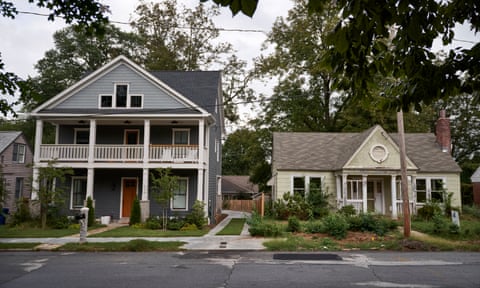Ahmad Cheers remembers the day a few years back when he knew his neighborhood was in the throes of change. He noticed a group of bikers, mostly white, riding though the northern tip of Pittsburgh, Atlanta, well after dark.
In some other parts of the city that may not have been remarkable, but here it took him aback.
“It just really surprised me,” said Cheers, 28. “When I came to Atlanta in 2008, to be honest you couldn’t really pay white people to come over here.”
Named for its resemblance to the steel-milling, hardscrabble Pennsylvania city in the north, Pittsburgh has long been a predominantly black (upwards of 95%, according to the 2010 census) and working-class section of southern in-city Atlanta.
Today the neighborhood, which was ravaged by the 2008 mortgage crisis, when it saw vacancy rates of up to 50%, is in the midst of an economic turnaround. Bright-yellow advertisements announcing “We buy houses” hang on nearly every utility pole and tree, posted by home flippers looking to make a quick buck as prices swell. Pittsburgh local Sohna Harzeez recalls a home down the street from her that was recently sold and painted, then relisted for $100,000 more than before.
A neighborhood becoming safe enough to bike in at night is, on the face of it, a good thing – Cheers himself is an avid rider. It is what so often follows that kind of change that worries him. Like other, similar Atlanta neighborhoods before it, Pittsburgh, with its cheap home prices and attractive location, is attracting wealthier, younger and yes, whiter people, stoking concerns that longtime residents will be pushed out by higher rents, property taxes and, possibly, a cultural shift that says they are no longer welcome.
“It’s scary to see who is going to be priced out of places that they’ve grown up in, and the places that they’ve lived and remained in for so long,” said Cheers.
Gentrification is affecting cities around the world, but housing advocates say there’s something especially unsettling about racial dynamics of those forces in Atlanta, a city historically described as a “black mecca”.

‘Developers just march over people’
Atlanta is also a special case in the history of housing in the US. It was the first city to develop public housing in 1936 and the first, early this century, to close it down completely, leaving all its housing subject to the invisible hand of market forces.
An analysis by Governing magazine ranked Atlanta fifth among US cities experiencing the most gentrification, with more than 46% of its census tracts currently gentrifying. According to the city, median rents are up 28% since 2000, compared with just 9% nationwide over the same timespan. A 2018 report by HotPads found rent in the city was rising three times faster than the national median. It also ranks third nationwide for evictions, with over 400 cases being processed a month.
According to the Brookings Institution demographer William Frey, the proportion of white people in Atlanta’s population grew faster between 2000 and 2006 than in any other US city. While it is true that over the past 20 years there has been a steady flow of black Americans to the Atlanta region, they’ve mostly settled in suburbs to the north – leaving the city center itself disproportionately attracting white Americans.
In no place is that more true than in the city’s Old Fourth Ward neighborhood, where Martin Luther King Jr grew up, and which is now home to the MLK historic national park.
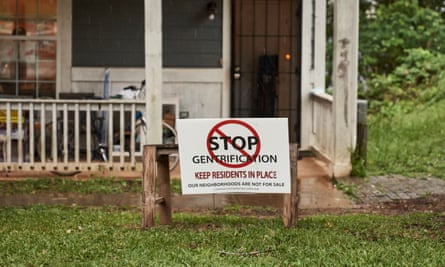
A ‘Stop Gentrification’ sign outside a home in the Pittsburgh neighborhood
Between 2000 and 2010 the percentage of white Americans in the ward more than doubled from 16% to 34%. And although the average sales price of a home was knocked off pace slightly by the housing crisis, it more than doubled from $126,000 to $290,000 between 2000 and 2018.
“Atlanta is developing so fast that there is nowhere for the poor to go,” said Elisabeth Omilami, CEO of Hosea Helps, which helps tackle hunger and homelessness in the city. “Soon there will be nowhere for the middle class to go.”
Omilami laments how her agency was forced to move from its home base of more than 27 years in Atlanta’s West End as prices skyrocketed. “It’s one of the hottest neighborhoods now – they’ve almost fully gentrified it and now they’re looking for the next,” Omilami said.
Driving the changes most is the Atlanta BeltLine, a multibillion dollar development project to repurpose a mostly disused and overgrown 22-mile ring of freight rail tracks into a corridor for transit trains, green space and walking and bike paths.
While it has been hailed for improving the city, the BeltLine has been contentious with residents who believe such improvements will lead to their own exclusion. The existing Westside Trail of the BeltLine is near Pittsburgh, and its forthcoming Southside Trail will go through the neighborhood.
As the city draws more transplants thanks to booming business in industries such as financial technology and film, the promise of nearby leisure space and easy transit has driven development and soaring prices along the BeltLine’s perimeter. A 2017 Georgia State University study found that home values within a half-mile of the BeltLine rose 17.9% to 26.6% more than locations in other parts of the city between 2011 and 2015.
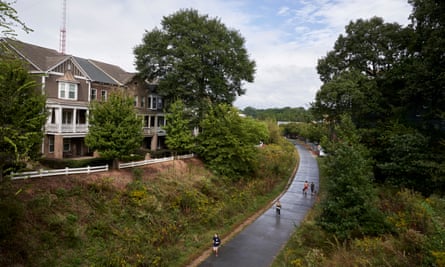
The BeltLine is seen by some as a driver of gentrification
Although it’s been 19 years since the BeltLine was first dreamed up as a graduate thesis by the then Georgia Tech student Ryan Gravel, the project has yet to open its first stretch of rail. That hasn’t stopped it from driving developers and homebuyers into aggressive investment and speculation. “You don’t want to miss out on one of Atlanta’s greatest opportunities,” warn local realtors looking to move properties in the 45 neighborhoods the BeltLine passes through.
Those communities adjacent to the proposed loop have become what film-maker King Williams, who spent years chronicling housing issues in the city for a recently released documentary, The Atlanta Way, calls “Atlanta’s new lakefront property”.
He says one of the BeltLine’s greatest ironies is that it was imagined by many as a potential hedge to gentrification, not its leading indicator. Atlanta is a notoriously car-oriented city with limited mass transit access, meaning only a few neighborhoods offered cheap and efficient paths to jobs or other destinations in the city center. In theory, making many neighborhoods more accessible and desirable should distribute demand that might otherwise fall in just one or two locations.
“It was supposed to be that anyone can live here and get from point A to point B, regardless of whether you make $1m or $10,000 a year,” said Williams. “That was the promise. But it’s not being invested in.”
Some think that may be changing, as earlier this month the metro region’s transit board approved $570m in funding which should get BeltLine light rail on the move. However, there is still a lack of investment in keeping housing affordable.
To head off the potentially detrimental effects of increasing home values, city legislators required that the project create at least 5,600 units of affordable housing. In 2017 an Atlanta Journal-Constitution investigation revealed that only 785 affordable homes had been funded, leading longtime BeltLine CEO Paul Morris to resign. Gravel, the mind behind the BeltLine, also quit the partnership, largely over frustration with the failures around housing affordability.
The interim BeltLine CEO has said affordable housing is a priority, but many people remain skeptical that even the best intentions can slow the push of powerful developers. “It’s so hard,” Omilami said, “looking out across the city that I love so much and seeing these developers just march over the people.”
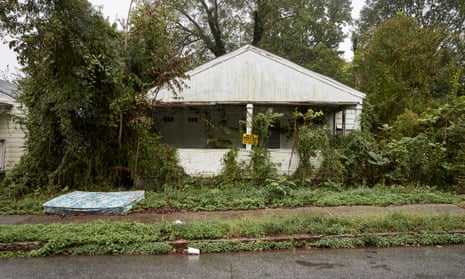
A city of firsts
Atlanta, perhaps now ironically, was the first city in the US to complete construction on a public housing project, with Techwood Homes replacing a stretch of blighted slums in the center in 1936. At a dedication in November that year, the president, Franklin D Roosevelt, hailed the “bright, cheerful” buildings as a “tribute to useful work under government supervision”. The white-only development was followed shortly by University Homes, a segregated offering for black people further downtown.
White Americans mostly left public housing in the 1950s and 60s as racially exclusionary government homeownership schemes like the GI bill fostered the expansion of suburbs and the emergence of the white middle class. Those same programs mostly left black people behind, while at the same time, government disinvestment caused the nation’s public housing stock to fall into disrepair. In Atlanta, by 1990, 10% of the city’s population lived in public housing – the highest percentage in the nation. Almost all were black.
The lead up to Atlanta hosting the 1996 Olympics set the city down the path to another first. The Techwood projects, now considered an ugly eyesore, were knocked down. Over the ensuing 15 years, under a federal program called Hope VI intended to revitalize the nation’s public housing, virtually all of the city’s projects were demolished.

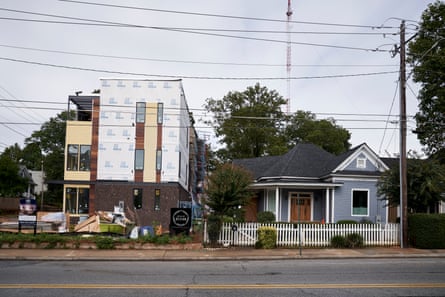
Houses in the Old Fourth Ward
Residents, wooed by the promise of glitzy new private mixed-income developments with set-asides for low-income housing, voted for the demolitions. By 2011, Atlanta had come full circle – from the first to open a public housing project to the first to have closed all of them down.
By comparison, New York City, the second city to erect public housing,still manages more than 400,000 units, across more than 300 developments.
The plan in Atlanta was never to replace the low-income housing capacity in the new developments one-for-one, but to accommodate those who did not come back with subsidies they could use to pay rent elsewhere – a program known as section 8. However, that leaves residents stuck with whichever landlords and properties choose to accept the vouchers – vouchers that decline in value as property prices go up.
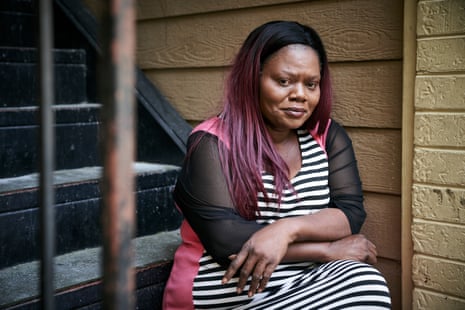
‘They don’t care about nobody they displace’
Gentrification forces hit Atlantans in different ways, creating complex problems to solve. In the past two years Cheryl Henderson has seen her rent swell from $599 to $850 a month. Her longtime apartment in Mays, about 10 miles east of downtown, has been besieged by air-quality issues due to mold, and property managers have told her that if she moves to a different unit with no mold issues, her rent will increase to $980 a month, an amount she cannot afford.
Like many working-class Atlanta renters, Henderson suspects she is caught up in a gambit by developers who see current tenants as an obstacle to renovating units and therefore attracting richer residents. “I think that they just look at this as an opportunity – as an investment – and they don’t care about nobody they displace,” Henderson said.
But it is also not always that simple.
At an affordable housing forum hosted by the city, landlord John Van Vlade described how a recent property tax assessment left his tax bill 50% of what he was collecting every month for modestly priced $800-a-month apartments.
“Either I’m going to have to tear it down and build luxury housing to make it viable or … something has to give,” he said.
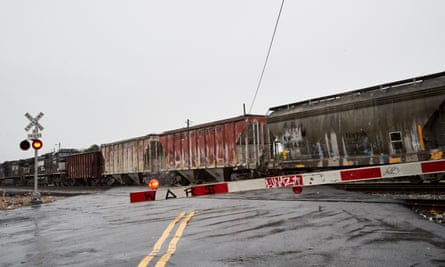
A freight train running through the Pittsburgh neighborhood
Unlike Atlanta’s Old Fourth Ward and the West End, where gentrification forces have already fundamentally reshaped the local topography and demographics, a number of neighborhoods to the south are still very much in flux.
Pittsburgh is a case in point.
Unlike the manicured mini-mansions of the city’s northern suburbs, the housing stock in Pittsburgh is mostly humble shotguns – long, skinny homes with rooms that open into one another – and bungalows set along narrow streets, many on steep hills.
Pittsburgh was devastated by the 2008 subprime mortgage crisis due to a glut of mortgage fraud and predatory lending, said Natallie Keiser, who leads the “neighborhood transformation efforts” in Atlanta for the Annie E Casey Foundation.
“There’s been a deep history over time of disinvestment in these communities and they’ve struggled with predatory practices,” Keiser said, “so there’s a lot of vacancy. There’s been a lot of blight.”
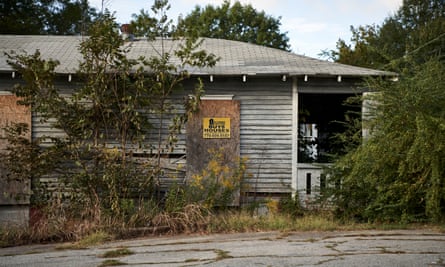

Housing in Pittsburgh
But Pittsburgh’s location leaves it primed to gentrify. It will soon be a BeltLine neighbourhood, and sits about 15 minutes equidistant from Atlanta’s downtown to the north and the world’s busiest airport, Hartsfield-Jackson, to the south.
Keiser said the prospect is something of a mixed bag. “Residents in these neighborhoods are of course eager for investment,” she said. “They want to see jobs, they want to see quality housing, they want to see grocery stores – but they also know that trying to get these types of services can mean economic change and stress for them. It can mean that property taxes rise and that rents rise, and they may not be able to afford to stay.”
Gentrification is also the story of subtle cultural frictions between old and new, black and white, rich and poor.
“It can be as simple as the way that people congregate,” said Alison Johnson, a housing advocate in Peoplestown, another predominantly black enclave along the BeltLine. “For a lot people around here, it’s normal to just hang out in front of the corner store where they grew up.”
New residents, she said, frequently react to such gatherings by calling law enforcement, which stirs up resentment.

‘I see it for what it’s going to be’
All of that concerns Cheers, for whom much of the frustration comes from noticing certain efforts only being made on the heels of new populations moving in: namely whiter and more affluent ones. He recalls noticing new laminated bus schedules and decorative fake flowers along Pittsburgh’s main drag, McDaniel Street, but he couldn’t help but feel slighted by the timing.
“It hurts, to be quite honest,” said Cheers. “It’s disappointing to see economic potential only thought to be real when other people come in, and not recognized for the culture that’s already here.”
Not everyone agrees. “As it stands today, Pittsburgh has no culture. Unless you call crime and blight culture,” said Devon Holloway, one of the founders of PittsburghATL Homeowners United.
For Holloway, who is black, and co-founder Tone Lane, who is white, change can’t come fast enough.
“I say diversification and inclusion versus gentrification,” Holloway said. “Because when you start diversifying the people, the places and things to do in a community, that changes that community to be sustainable and inviting.”
Not only is Pittsburgh slated to get a slice of the BeltLine running along its southern flank, but it is also the site of a 31-acre industrial development project named Pittsburgh Yards, spearheaded by the Annie E Casey Foundation. Billed as a “commercial village with a wide variety of tenants” and an “urban business park”, it will also contain affordable housing units. Lane and Holloway see this as a game-changer for the neighborhood that will drive dramatic cultural shifts.
“We would love to see dogs on leash, bicycles, people having coffee,” Lane said. “A sense of community.”

Tone Lane and Devon Holloway of the Pittsburgh Homeowners Association
Lane, who came to Pittsburgh 10 years ago around the nadir of the housing collapse, mostly views the community in terms of potential. “I saw it for what it was going to be. I still see it for what it’s going to be,” Lane said. “It’s a lovely little community if you could just take a magic eraser and erase all the ills.”
Among them he counts gang activity, blighted properties and crime, especially prostitution, as well as “mindset”. “There is going to be more energy around this dormant complacency that happens in Pittsburgh,” Lane said.
That’s a script that housing advocates like Johnson don’t buy. “We’ve been reaching and yelling out for resources to help mitigate these issues for decades and decades and they have been ignored and ignored,” she said.
“That’s a misconception, to say that people in their community don’t want to see their home values rise, don’t want to see criminal activities decrease.
“But we want to make sure that we’re doing that in a way that doesn’t disrespect folks that are there and doesn’t dishonor something that these communities have been working towards for so long.”
This article was edited on 23 October to correct a reference to a 2017 study by Dan Immergluck and Tharunya Balan that wrongly credited Georgia Tech instead of Georgia State University
Guardian Cities is live in Atlanta for a special series of in-depth reporting. Share your experiences of the city in the comments below, on Twitter, Facebook and Instagram using #GuardianATL, or via email to cities@theguardian.com
